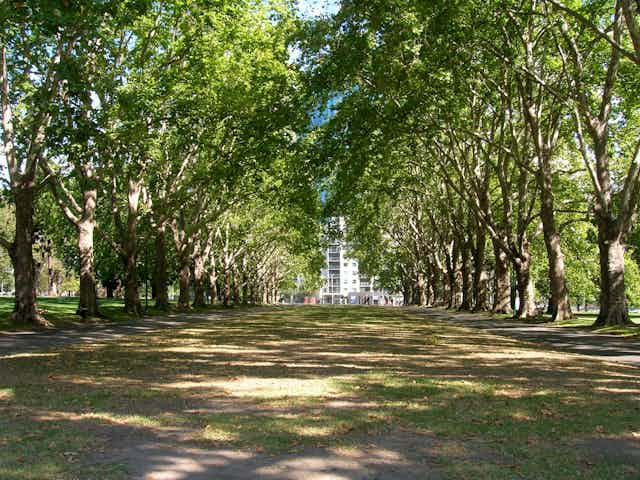The internet exploded recently with news that you can email trees in Melbourne. For the last two years, residents and visitors have sent thousands of emails to their favourite tree, particularly one much-loved golden elm.
“I see you every morning, watch you change with the seasons. It makes me happy knowing you are there,” emailed one resident.
At first glance, the idea of emailing a tree can seem a strange and wacky thing, but this email is one of thousands the City of Melbourne has received via its Urban Forest Visual which maps every public tree in the City.
The fact that Melburnians have embraced the notion of emailing a tree is no surprise. We have been passionate about trees in cities for a long time.
In 1871, a correspondent to Melbourne’s Argus argued that more trees were needed:
The beauty of the city, its coolness, its freedom from ground damp (which the trees would absorb), street currents of air, would all be enhanced; the expense and horrid ugliness of verandahs would be saved, and our taste would be complimented.
Our research explores the how people see and think about nature, sometimes trees and garden plants, but also weeds, “ferals”, and native plants and animals. This research shows consistently that nature is really important to people for many different reasons, and always in ways that differ from experts and professionals.
More trees in cities
Around the world, many cities have been undertaking massive urban tree expansion and renewal programs. Million Tree initiatives have begun in many cities including Los Angeles, New York and Shanghai. These aim primarily to plant more trees, but also manage the resilience of the forest by increasing species diversity, and encourage community participation in choosing locations and kinds of tree, and stewardship by adopting and caring for trees.
The City of Melbourne’s urban forest program is also using cutting-edge research to increase tree canopy cover, manage diversity in the forest, and reduce heat in summer. Yet it is perhaps through new ways of valuing trees, and through community engagement programs such as emailing a tree, that the City of Melbourne is being most innovative.
Why do we value trees?
By valuing, we mean determining the importance of trees. Trees have always been valued by urban people, but the way they have justified their value has constantly changed.
Some of Melbourne’s most frenzied tree planting occurred during the late 19th and early 20th century based on arguments that valued trees for “beautifying” the city, a concept that included improving human morality and mental health.
In recent decades, the emergence of the Ecosystem Services framework has allowed the benefits provided by trees such as temperature reduction, carbon sequestration and pollution interception to be quantified and valued in dollar terms. This thinking has led to recent initiatives such as the price-tagging of trees.
Yet the price of a tree tells us only a little about how important trees are to people. Recent community engagement work that we have been doing with the City of Melbourne using social psychology methods has identified multiple ways that the public values urban trees: for their contribution to civic identity, as nature, for their cultural heritage, to improve the community, and for their life sustaining properties.
It is clear that all these values need to be well represented in the urban forest to satisfy the community. This work has used a variety of methods such as questionnaires, value mapping, and photo sorts that have proven to be useful in helping the community understand the issues behind the urban forest program, and perhaps more importantly, to involve the community in decision making.
People’s emails to trees could provide some surprising insights into how people relate to trees, rather than just benefit from them. The emotional basis of this relationship is very strong (such as “I very fond of you [sic]”, “I miss you”, “It makes me happy knowing you are there”, and “It saddens me that your passing will be sooner than my own”).
Although the framing of trees as “ecosystems services” or “green infrastructure” are undoubtedly useful tools for directing the wheels of urban development, there is real power in understanding people’s emotional relationship with trees. Healthy, liveable and lovable cities need to allow people’s subtle and nuanced spiritual and emotional bond with trees to thrive.

